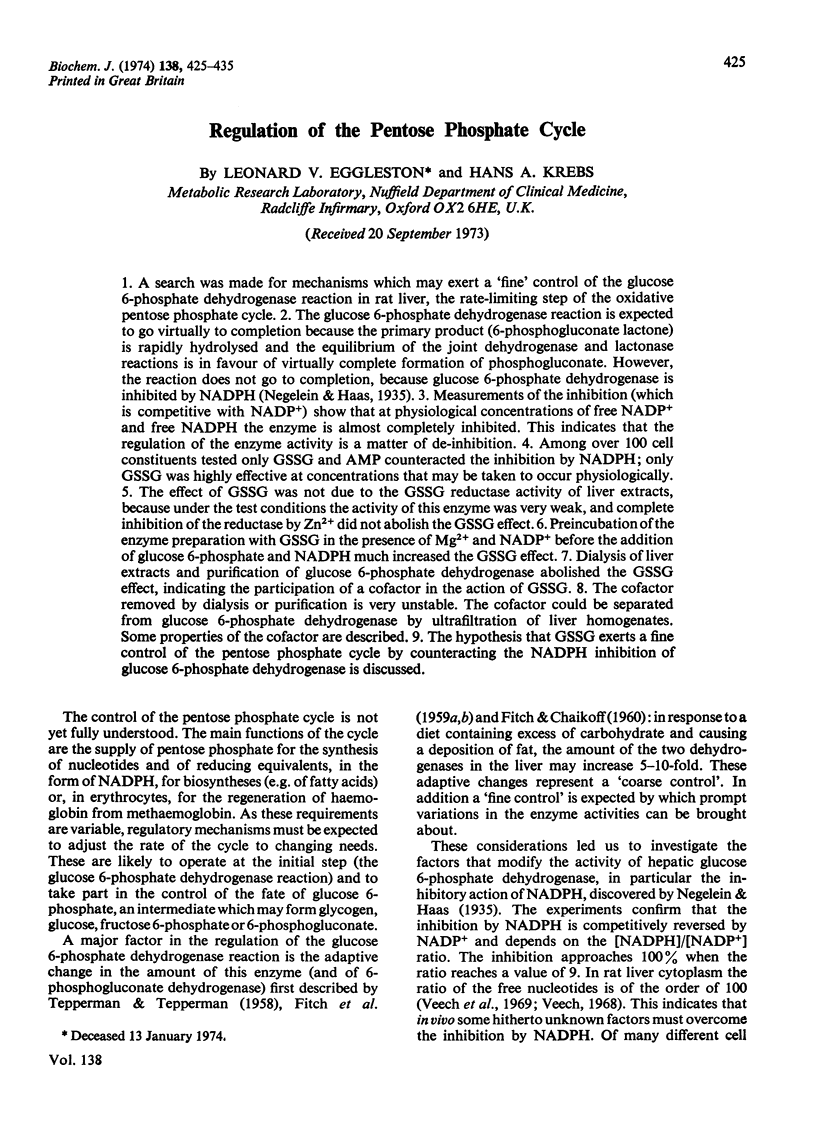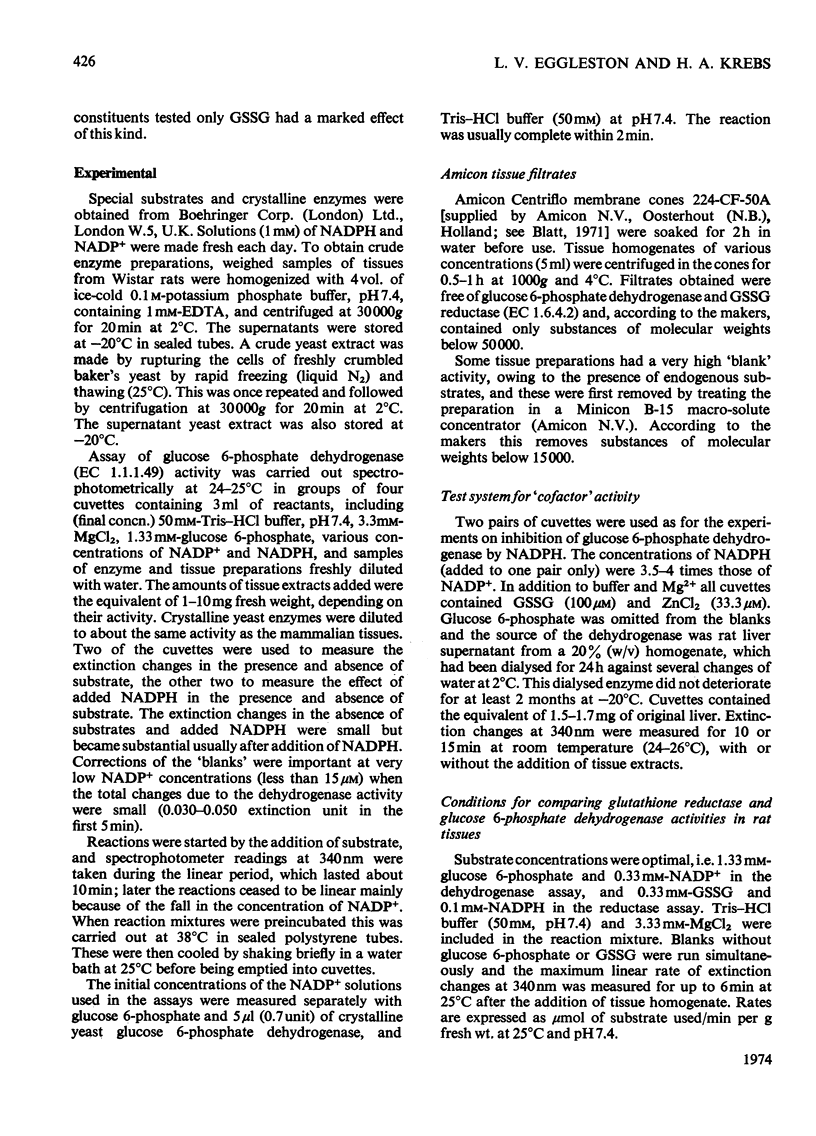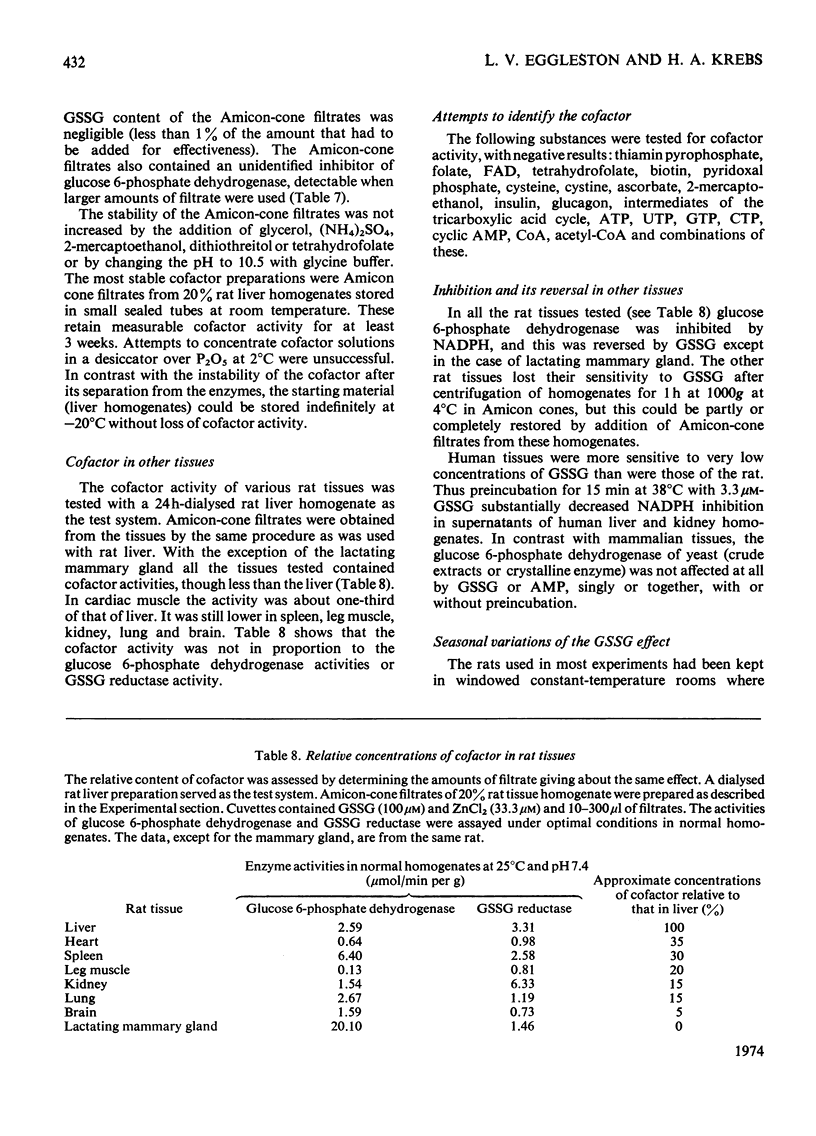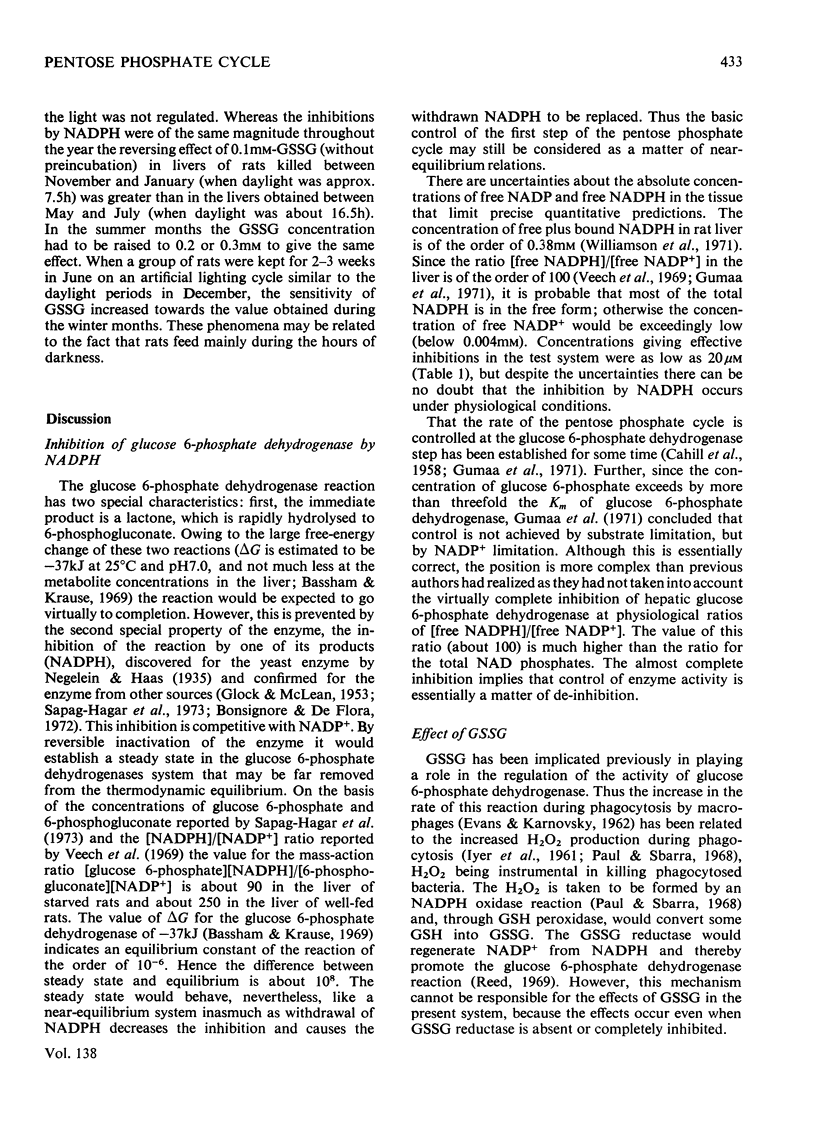Abstract
1. A search was made for mechanisms which may exert a `fine' control of the glucose 6-phosphate dehydrogenase reaction in rat liver, the rate-limiting step of the oxidative pentose phosphate cycle. 2. The glucose 6-phosphate dehydrogenase reaction is expected to go virtually to completion because the primary product (6-phosphogluconate lactone) is rapidly hydrolysed and the equilibrium of the joint dehydrogenase and lactonase reactions is in favour of virtually complete formation of phosphogluconate. However, the reaction does not go to completion, because glucose 6-phosphate dehydrogenase is inhibited by NADPH (Neglein & Haas, 1935). 3. Measurements of the inhibition (which is competitive with NADP+) show that at physiological concentrations of free NADP+ and free NADPH the enzyme is almost completely inhibited. This indicates that the regulation of the enzyme activity is a matter of de-inhibition. 4. Among over 100 cell constituents tested only GSSG and AMP counteracted the inhibition by NADPH; only GSSG was highly effective at concentrations that may be taken to occur physiologically. 5. The effect of GSSG was not due to the GSSG reductase activity of liver extracts, because under the test conditions the activity of this enzyme was very weak, and complete inhibition of the reductase by Zn2+ did not abolish the GSSG effect. 6. Preincubation of the enzyme preparation with GSSG in the presence of Mg2+ and NADP+ before the addition of glucose 6-phosphate and NADPH much increased the GSSG effect. 7. Dialysis of liver extracts and purification of glucose 6-phosphate dehydrogenase abolished the GSSG effect, indicating the participation of a cofactor in the action of GSSG. 8. The cofactor removed by dialysis or purification is very unstable. The cofactor could be separated from glucose 6-phosphate dehydrogenase by ultrafiltration of liver homogenates. Some properties of the cofactor are described. 9. The hypothesis that GSSG exerts a fine control of the pentose phosphate cycle by counteracting the NADPH inhibition of glucose 6-phosphate dehydrogenase is discussed.
Full text
PDF










Selected References
These references are in PubMed. This may not be the complete list of references from this article.
- Bassham J. A., Krause G. H. Free energy changes and metabolic regulation in steady-state photosynthetic carbon reduction. Biochim Biophys Acta. 1969 Oct 21;189(2):207–221. doi: 10.1016/0005-2728(69)90048-6. [DOI] [PubMed] [Google Scholar]
- Bonsignore A., Lorenzoni I., Cancedda R., Nicolini A., Damiani G., De Flora A. Purification of glucose 6-phosphate dehydrogenase from human erythrocytes. Ital J Biochem. 1970 May-Jun;19(3):165–177. [PubMed] [Google Scholar]
- CAHILL G. F., Jr, HASTINGS A. B., ASHMORE J., ZOTTU S. Studies on carbohydrate metabolism in rat liver slices. X. Factors in the regulation of pathways of glucose metabolism. J Biol Chem. 1958 Jan;230(1):125–135. [PubMed] [Google Scholar]
- EVANS W. H., KARNOVSKY M. L. The biochemical basis of phagocytosis. IV. Some aspects of carbohydrate metabolism during phagocytosis. Biochemistry. 1962 Jan;1:159–166. doi: 10.1021/bi00907a024. [DOI] [PubMed] [Google Scholar]
- FITCH W. M., CHAIKOFF I. L. Extent and patterns of adaptation of enzyme activities in livers of normal rats fed diets high in glucose and fructose. J Biol Chem. 1960 Mar;235:554–557. [PubMed] [Google Scholar]
- FITCH W. M., HILL R., CHAIKOFF I. L. Hepatic glycolytic enzyme activities in the alloxan-diabetic rat: response to glucose and fructose feeding. J Biol Chem. 1959 Nov;234:2811–2813. [PubMed] [Google Scholar]
- FITCH W. M., HILL R., CHAIKOFF I. L. The effect of fructose feeding on glycolytic enzyme activities of the normal rat liver. J Biol Chem. 1959 May;234(5):1048–1051. [PubMed] [Google Scholar]
- GLOCK G. E., McLEAN P. Further studies on the properties and assay of glucose 6-phosphate dehydrogenase and 6-phosphogluconate dehydrogenase of rat liver. Biochem J. 1953 Oct;55(3):400–408. doi: 10.1042/bj0550400. [DOI] [PMC free article] [PubMed] [Google Scholar]
- Gumaa K. A., McLean P., Greenbaum A. L. Compartmentation in relation to metabolic control in liver. Essays Biochem. 1971;7:39–86. [PubMed] [Google Scholar]
- Güntherberg H., Rapoport S. Eine Methode zur Bestimmung des oxydierten Glutathions in Geweben. Acta Biol Med Ger. 1968;20(5):559–564. [PubMed] [Google Scholar]
- LEVY H. R. The interaction of mammary glucose 6-phosphate dehydrogenase with pyridine nucleotides and 3beta-hydroxyandrost-5-en-17-one. J Biol Chem. 1963 Feb;238:775–784. [PubMed] [Google Scholar]
- MIZE C. E., LANGDON R. G. Hepatic glutathione reductase. I. Purification and general kinetic properties. J Biol Chem. 1962 May;237:1589–1595. [PubMed] [Google Scholar]
- Matsuda T., Yugari Y. Glucose-6-phosphate dehydrogenase from rat liver. I. Crystallization and properties. J Biochem. 1967 May;61(5):535–540. doi: 10.1093/oxfordjournals.jbchem.a128583. [DOI] [PubMed] [Google Scholar]
- Paul B., Sbarra A. J. The role of the phagocyte in host-parasite interactions. 13. The direct quantitative estimation of H2O2 in phagocytizing cells. Biochim Biophys Acta. 1968 Feb 1;156(1):168–178. doi: 10.1016/0304-4165(68)90116-5. [DOI] [PubMed] [Google Scholar]
- Reed P. W. Glutathione and the hexose monophosphate shunt in phagocytizing and hydrogen peroxide-treated rat leukocytes. J Biol Chem. 1969 May 10;244(9):2459–2464. [PubMed] [Google Scholar]
- Sapag-Hagar M., Lagunas R., Sols A. Apparent unbalance between the activities of 6-phosphogluconate and glucose-6-phosphate dehydrogenases in rat liver. Biochem Biophys Res Commun. 1973 Jan 4;50(1):179–185. doi: 10.1016/0006-291x(73)91080-2. [DOI] [PubMed] [Google Scholar]
- States B., Segal S. Distribution of glutathione-cystine transhydrogenase activity in subcellular fractions of rat intestinal mucosa. Biochem J. 1969 Jun;113(2):443–444. doi: 10.1042/bj1130443. [DOI] [PMC free article] [PubMed] [Google Scholar]
- States B., Segal S. Interrelationship of glutathione-cystine transhydrogenase and glutathione reductase in developing rat intestine. Biochem J. 1973 Mar;132(3):623–631. doi: 10.1042/bj1320623. [DOI] [PMC free article] [PubMed] [Google Scholar]
- TEPPERMAN J., TEPPERMAN H. M. Effects of antecedent food intake pattern on hepatic lipogenesis. Am J Physiol. 1958 Apr;193(1):55–64. doi: 10.1152/ajplegacy.1958.193.1.55. [DOI] [PubMed] [Google Scholar]
- Veech R. L., Eggleston L. V., Krebs H. A. The redox state of free nicotinamide-adenine dinucleotide phosphate in the cytoplasm of rat liver. Biochem J. 1969 Dec;115(4):609–619. doi: 10.1042/bj1150609a. [DOI] [PMC free article] [PubMed] [Google Scholar]
- Wendell P. L. Measurement of oxidized glutathione and total glutathione in the perfused rat heart. Biochem J. 1970 May;117(4):661–665. doi: 10.1042/bj1170661. [DOI] [PMC free article] [PubMed] [Google Scholar]
- Wrigley N. G., Heather J. V., Bonsignore A., De Flora A. Human erythrocyte glucose 6-phosphate dehydrogenase: electron microscope studies on structure and interconversion of tetramers, dimers and monomers. J Mol Biol. 1972 Jul 28;68(3):483–499. doi: 10.1016/0022-2836(72)90101-5. [DOI] [PubMed] [Google Scholar]
- Yue R. H., Noltmann E. A., Kuby S. A. Glucose 6-phosphate dehydrogenase from brewers' yeast (Zwischenferment). 3. Studies on the subunit structure and on the molecular association phenomenon induced by triphosphopyridine nucleotide. J Biol Chem. 1969 Mar 10;244(5):1353–1364. [PubMed] [Google Scholar]


